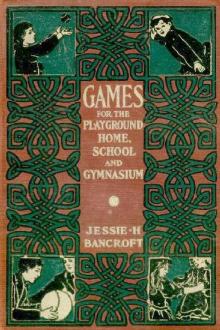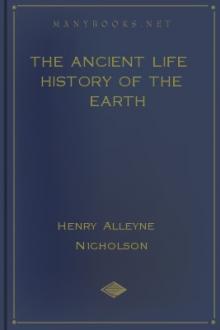Games for the Playground, Home, School and Gymnasium by Jessie Hubbell Bancroft (top novels of all time .txt) 📕

- Author: Jessie Hubbell Bancroft
- Performer: -
Book online «Games for the Playground, Home, School and Gymnasium by Jessie Hubbell Bancroft (top novels of all time .txt) 📕». Author Jessie Hubbell Bancroft
In ethnology the study of the origin and distribution of games "furnishes," says Mr. Culin, "the most perfect existing evidence of the underlying foundation of mythic concepts upon which so much of the fabric of our culture is built." The most scientific work on the entire subject of games lies in this direction. As revealed by board and other implement games the element of sport does not originally inhere in a game, the procedure being a rite of magic or religion, pursued mainly as a means of divination. In Mr. Culin's opinion, "the plays of children must be regarded apart from games, being dramatic and imitative, although copying games as they [the children] copy other affairs of life, and thus often preserving remains of ceremonials of remote antiquity."
From the folklore viewpoint Mrs. Gomme and Mr. Newell have brought to bear on games a wealth of knowledge of old customs and beliefs, discerning thereby a significance that might otherwise pass unnoticed and unappreciated. Thus we have the recognition of old well-worship rites in the little singing game "Draw a Bucket of Water"; of ancient house ritual in some of the dramatic games; in others the propitiation of deities that preside over the fertility of the fields; survivals of border warfare; of old courtship and marriage observances, and many other rites and customs. Sometimes this recognition is merely one of analogy or association, leading to a surmise of the origin of a game; sometimes it is supported by old records and drawings or references found in early literature. While often not so exact as the strictly scientific method, this folklore study throws a flood of light on the heritage of games that passes from child to child, giving to the subject added dignity and worth. One comes to appreciate that the childhood bereft of this heritage has lost a pleasure that is its natural right, as it would if brought up in ignorance of Jack the Giant Killer, Beauty and the Beast, or Robinson Crusoe.
The class of games studied by the folklorists mentioned includes mainly those of active and dramatic character as distinguished from the board and implement games. Mrs. Gomme sees in their form, method of playing, the dialogue often included, and the fact of their continuance from generation to generation, an expression of the dramatic instinct, and considers them a valuable adjunct in the study of the beginnings of the drama. The student of games must find of great interest Mrs. Gomme's classification by formation, the line form being considered to represent, or to have grown out of, a contest between people from different countries or localities; the circle formation a representation of customs prevailing in one village, town, or tribe, and so on, with the arch form or tug of war, the winding-up games (as in Snail), etc.
Viewed in this light of their origin, games are especially fascinating. They take one back to the atmosphere that pervades romance: to quaint chronicles of kings and courtiers setting forth in brilliant train for some game that is the heritage of the child of to-day; to ladies-in-waiting on the Queen playing Babylon; to shepherds congregating on the moors, or early village communities dividing, over some forerunner of our college Football; to village lads and lasses dodging through the cornstalks with Barley Break, or milkmaids playing Stool Ball with their stools. For while it is rightly said that the serious occupations of adults at one period become the games of children at another, the statement omits an intermediate fact that strongly impresses the student of games: namely, that these activities, which at first were serious rites have been used for sport by adults themselves before being handed down to children; as though the grown folk should masquerade for a time in their outworn garments before passing them on to following generations. Considering the varied interests that find expression in these games, one is further impressed with the fact that humanity passes thus in review its entire range of experience, transmuting into material for sport the circumstances of love and hatred, sorrow and rejoicing, fear and veneration. Nothing is too exalted or humble, too solemn or fearsome, to be the subject of these frolic events. Nature in all her panoply is here in dramatized form or reference—earth, stone, fire, and water; verdure and the kingdom of living things from beast to man; the seasons and the planets. Industry, love and war, fiends and deities, death itself and the hereafter, all pass in review, for one who sees the hidden significance, like a panorama of existence, as they passed, a plaything and a jest, before the gods of Olympus. It would seem as though humanity, viewing in long perspective its own experiences, had found them all at last fit subjects to
One dares to hope that this little craft, bearing as it does such a freight of gladness, may leave behind a wake of cheer, and laughter, and happiness.
March, 1909.
ACKNOWLEDGMENTSDetailed acknowledgment is made throughout the volume to various authors and publishers. A general assurance of most grateful appreciation is here tendered to many who have responded with material and suggestions in the research, and to the numerous teachers whose resourcefulness has led to the adaptation of many games to school conditions. The author regrets the impracticability of mentioning all of these by name.
Especial acknowledgment is due Mrs. Marie Talbot Constant for most valuable and varied assistance, particularly in bibliographical research and cataloguing of games; and to Miss Lilian M. McConville for testing and adapting many foreign games collected for the present volume.
TO THE TEACHER OF GAMESThe following suggestions are made with a view to the use of games under any circumstances, though many of them apply especially to large numbers of players under the guidance of a teacher or leader, as in playgrounds and schools.
The leader or teacher of a playground should approach his or her work largely in the spirit of the host or hostess whose duty it is to see that each individual guest is happy and has opportunity to share all of the pleasures of the occasion. But much more than this is involved in the relation of teacher and pupil. The teacher of games, or leader of children's play, needs, like all teachers, to have a sympathetic personal understanding of the players; a quick insight into character and motive; a knowledge of what to look for in the child's development at different periods, as indicated in the Introduction; and to be, in short, guide, philosopher, and friend.
The teacher should never hesitate, from questions of personal dignity, to participate in the play of children. Nothing can more quickly gain the respect and affection of a child than such participation. Every adult can doubtless recall the extreme pleasure experienced in childhood when some grown person entered into the childish play. In schools, where there is necessarily so much of formal discipline and dealing with large numbers en masse, one of the most valuable effects of games is to produce a more natural and sympathetic relationship between teacher and pupil, and a fuller appreciation on the part of the teacher of child nature. This effect from the use of games has been noted by scores of teachers, even those who were at first opposed to such use.
Every teacher will have his or her individual methods for teaching, discipline, and management of games. The following general suggestions, however, are the result of experience, and may be of assistance to the novice, at least.
The best method of teaching a game is to make a full explanation of it before the pupils take their places to play. If this be in a schoolroom, illustrative diagrams may often be drawn on the blackboard, and it is sometimes helpful, there or elsewhere, to have a few pupils go slowly (not running) through the general form of the game, to illustrate it to the others. In a playground the same method may be used by having the players sit, if that be feasible, or by halting them in a march or after gymnastic exercises, to listen to the explanation. Never try to teach and play a game at the same time. The only exception to this rule should be where there is a large and disorderly crowd with which to deal. Then it may occasionally be best to start a game to gain interest and attention, and then halt for further explanation.
It often becomes necessary for the sake of discipline and unity to unite all of the players in a playground in one game. Comparatively few games, however, are successful when played by very large numbers. A special index has been prepared of such games, however, and will be found at the end of the present volume. Classes may often be brought into order and attention in a playground by the simple device of marching, the march to end in one game for all of the players, or several games in groups.
An indication that too many players are taking part in a game is almost invariably to be found in a lack of interest on the part of the players, arising usually from the infrequency with which each player gets an opportunity to participate. The ultimate test of any game, however, from the recreative standpoint must be one of interest, and this is often found among players who are not participating in the action if competition be close. A teacher should watch closely for waning interest, and may often save the situation by dividing the players into two or more groups. Many games that are commonly listed for as many as sixty players are given in the present index as useful for "thirty or more." By this is meant that the best playing values of the game are lost when played by more than thirty, although it is possible to use the game with a larger number. Very frequently even these games are far better played by smaller groups.
A resourceful teacher will find many ways of adapting games to large numbers. Among such devices may be mentioned (1) increasing the number of runners and chasers; for instance, in the game of Cat and Rat, there may be several cats and several rats; (2) in the circle games of simple character, especially the singing games, the circle may be duplicated, thus having two concentric circles, one within the other; (3) in many ball games it will be found possible to put more than one ball in play, as in Bombardment or Circle Club Bowls. Such suggestions as this are often made in the present volume





Comments (0)